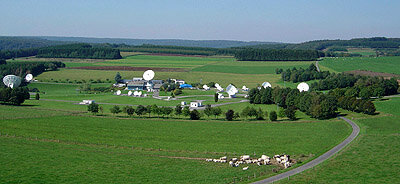Ground operations ready for Proba-2
Once in orbit, experts from ESA's Operations team will oversee Proba-2's daily activities. They are using innovative, low-cost mission control hardware and software, and the mission's valuable data will be distributed via the Internet.
The Proba satellites are part of ESA’s In-orbit Technology Demonstration Programme, missions dedicated to the demonstration of innovative technologies. Small, low-cost missions allow small companies access to space and provide them with the experience that is essential for European industries to be competitive and innovative.
Like its predecessor Proba-1 - launched in 2001 and still in operation - ESA's Proba-2 satellite will make use of low-cost hardware and software for daily mission control activities. Many of the tasks involved in planning scientific observations, conducting on-board technology test activities and uploading spacecraft commands will be automated, including the daily download of science and technical data via ESA's Redu ground station.
Satellite operations use ground segment automation
"Due to the mission design, we will simply work normal business hours - there will be little need for spacecraft engineers to work shifts, and only limited back-up is necessary for the ground control system. Operating this satellite is facilitated by the high level of onboard autonomy and ground segment automation," says Etienne Tilmans, senior Mission Operations Engineer for both Proba-1 and -2 at Redu station in Belgium.
Science data distributed via the Internet
The 'ground segments' - the systems used on the ground to operate a satellite in space and distribute its data - for Proba-1 and -2 use off-the-shelf system components based on free-to-obtain 'open-source' software together with a set of highly flexible software tools developed by the team; the data received from the satellites are distributed to scientists via regular web servers.

In addition to Tilmans, the Proba-1 Operations team at Redu comprises just two engineers and a spacecraft analyst; an additional engineer joined the team for Proba-2. The Redu team works closely with industry specialists and the scientists that will later receive the data for analysis.
At Redu, a pair of small S-Band antennas will meet most communication needs for both missions; Proba-1 also makes use of a station at Kiruna, Sweden, for image data download, while Proba-2 also uses the station at Svalbard for both telecommanding and data download.
ESA's own 'open source' mission control software
The Proba mission control systems make use of ESA's standard SCOS (spacecraft operating system) 2000 software, which can be licensed freely following an open-source model, just like other free software used by businesses and consumers on the Internet.
"This meant that building the Proba ground segment was relatively streamlined. The SCOS2000 software has been used since the start of the project and it has been enhanced with automation features; any problems detected can be notified to our team by email, for example," says Tilmans.

Despite the automation and relative simplicity of the two Proba ground segments, the team at Redu have ongoing maintenance, update and monitoring tasks and must still do planning and scheduling.
Proba-1, now operated as an Earth Observation mission, carries several optical instruments. Their observation targets must be planned and commanded. Proba-2, which will be operated as a Sun-observing science mission in addition to its technology demonstration role, carries four science instruments and will gather data 24 hrs/day, which will be distributed to scientists via the Web autonomously. Consequently, its science data workload is not large.
"But Proba-2 has 17 separate technology demonstration devices or features, and we will be busy 'juggling' certain devices on or off at certain times according to their test campaigns, and to make sure we get the monitored results of the tests, at least during the first year of operation," says Tilmans.
Redu team supported by experts at ESOC

The Redu Operations team can also rely on support from colleagues throughout the Agency, but especially at ESOC, ESA's European Space Operations Centre, Darmstadt, Germany. ESOC is where ESA's 'large' satellite missions are operated - currently 11 missions comprising 14 spacecraft, including interplanetary missions, astronomical observatories and Earth observation satellites.
"Just like any of our missions operated here at ESOC, we can provide assistance with flight dynamics, ground stations or any other problem with the ground segment. Even if they are 'smaller' missions, the Probas are crucial and we are available to support them as necessary," says John Dodsworth, Head of Third-Party Mission Support at ESOC.
2 November: critical launch and early orbit activities
On 2 November 2009, Tilmans and the team at Redu will monitor the launch, separation and receipt of first signal from Proba-2, together with engineers from the Verhaert Design and Development team, the industry contractor who has built the satellite and that will hand over the mission in orbit for routine control by the ESA team.
Proba-2 is scheduled for launch, together with ESA's SMOS satellite, on a Rockot launcher from the Plesetsk Cosmodrome in northern Russia at 02:50 CET. Proba-2 will separate from the Rockot launcher after SMOS, during Orbit 7, at 05:50:06 CET. Acquisition of first signal via Redu station is expected at 05:59:10 CET.
Tilmans says that Proba-1 started eight years ago as the first low-cost, low-resource technology demonstrator; it also had Earth-observation data-gathering capabilities. "It took several months for Proba-1 to show that it could deliver not only technology testing but also 'real' scientific data. With Proba-2, even before launch, the science community already expect real data and real results - it's a very exciting future," says Tilmans.















 Germany
Germany
 Austria
Austria
 Belgium
Belgium
 Denmark
Denmark
 Spain
Spain
 Estonia
Estonia
 Finland
Finland
 France
France
 Greece
Greece
 Hungary
Hungary
 Ireland
Ireland
 Italy
Italy
 Luxembourg
Luxembourg
 Norway
Norway
 The Netherlands
The Netherlands
 Poland
Poland
 Portugal
Portugal
 Czechia
Czechia
 Romania
Romania
 United Kingdom
United Kingdom
 Slovenia
Slovenia
 Sweden
Sweden
 Switzerland
Switzerland































